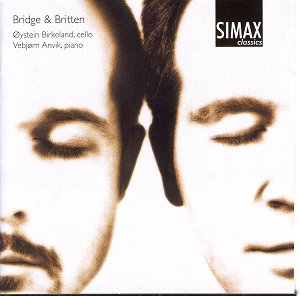Although the string of short pieces by Bridge are placed after the two sonatas I played them first. What utterly lovely miniatures the Meditation and Spring Song are! Bridge wrote neatly-turned salon pieces rather in the manner of Chaminade right from the beginning of his career, as we hear in the Berceuse (1901), Scherzo (1902) and Serenade (1903), while the Elegie (1904) goes further, expressing deep feeling. But around 1910 (the first-period masterpiece "The Sea" dates from 1911) they started to acquire more point and focus. "Cradle Song" (1910) is exquisite and Melodie (1911) is a glorious outpouring. The two pieces I mentioned at the beginning are thought to be from 1912. I would place these last four on a level with those very few imperishable short pieces Fauré wrote for cello and piano, indispensable among the cello's repertoire of miniatures.
And then we have the darkly brooding, powerfully impassioned Sonata of 1913-1917. Clear-cut in form, thematically distinguished, every note of it strikes home to the listener. Birkeland, who played the miniatures with much natural musicianship, proves a magnificent cellist, with a tone that is autumnal and passionate as required and a deep understanding of the way each phrase is to be shaped. Anvik is nearly on the same level. When a phrase passes from one to the other it is noticeable that it sounds a tad more four-square on the piano, but the partnership works well and the performance has an overwhelming impact. This Sonata is one of those select British works which belong to the international repertoire without hesitation or apology.
Bridge's most famous pupil Britten, after a few early works of passionate force ("Peter Grimes" is obviously one of them) settled into a run-of-the-mill, even stick-in-the-rut, midstream modernism. Texturally inventive and probably deeply felt, this Sonata's themes are nonetheless sow's ears and you can't … well, you know the proverb.
The two Sonatas were recorded by Rostropovich and Britten. They obviously have a unique authority, but Birkeland is a cellist who should be heard, and he gives us the Bridge miniatures as well.
Excellent recording and detailed notes from Malcolm MacDonald, who informs us that Bridge's music is "now regularly performed". I wonder how many live performances he has attended of the works here over the last twelve months. The cover is trendy but the black and white photos inside by Tomas Trægde Lorntzen are of striking beauty and very well matched to the mood of the Bridge Sonata.
Christopher Howell

![]() Øystein Birkeland
(violoncello), Vebjørn Anvik (pianoforte)
Øystein Birkeland
(violoncello), Vebjørn Anvik (pianoforte)![]() SIMAX PSC 1160 [70.16]
SIMAX PSC 1160 [70.16]